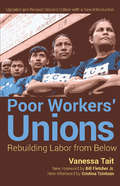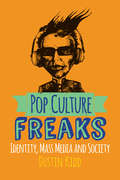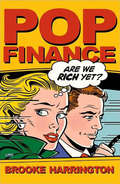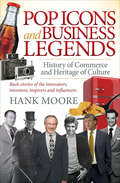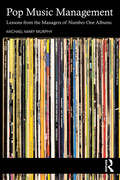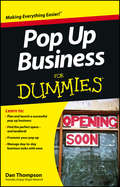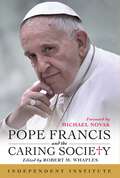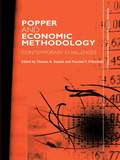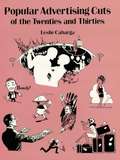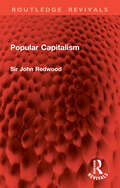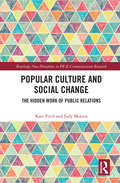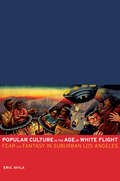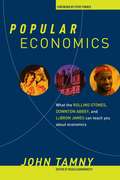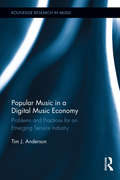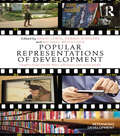- Table View
- List View
Poor Worker's Unions: Rebuilding Labor from Below (Completely Revised and Updated Edition)
by Cristina Tzintzún Vanessa TaitA classic account of low-wage workers' organization that the US Department of Labor calls one of the "100 books that has shaped work in America."As low-wage organizing campaigns have been reignited by the Fight for 15 movement and other workplace struggles the classic Poor Workers' Unions-one of the 100 books the US Department of Labor says has "shaped work in America"-is as prescient as ever.
Poorly Made in China: An Insider's Account of the China Production Game
by Paul MidlerAn insider reveals what can—and does—go wrong when companies shift production to China In this entertaining behind-the-scenes account, Paul Midler tells us all that is wrong with our effort to shift manufacturing to China. Now updated and expanded, Poorly Made in China reveals industry secrets, including the dangerous practice of quality fade—the deliberate and secret habit of Chinese manufacturers to widen profit margins through the reduction of quality inputs. U.S. importers don’t stand a chance, Midler explains, against savvy Chinese suppliers who feel they have little to lose by placing consumer safety at risk for the sake of greater profit. This is a lively and impassioned personal account, a collection of true stories, told by an American who has worked in the country for close to two decades. Poorly Made in China touches on a number of issues that affect us all.
Pop Culture Freaks
by Dustin KiddLove it or hate it, popular culture permeates every aspect of contemporary society. In this accessibly written introduction to the sociology of popular culture, Dustin Kidd provides the tools to think critically about the cultural soup served daily by film, television, music, print media, and the internet. Utilizing each chapter to present core topical and timely examples, Kidd highlights the tension between inclusion and individuality that lies beneath mass media and commercial culture, using this tension as a point of entry to an otherwise expansive topic. He systematically considers several dimensions of identity--race, class, gender, sexuality, disability--to provide a broad overview of the field that encompasses classical and contemporary theory, original data, topical and timely examples, and a strong pedagogical focus on methods. Pop Culture Freaks encourages students to develop further research questions and projects from the material. Both quantitative and qualitative analyses are brought to bear in Kidd’s examination of the labor force for cultural production, the representations of identity in cultural objects, and the surprising differences in how various audiences consume and use mass culture in their everyday lives.
Pop Finance: Investment Clubs and the New Investor Populism
by Brooke HarringtonDuring the 1990s, the United States underwent a dramatic transformation: investing in stocks, once the province of a privileged elite, became a mass activity involving more than half of Americans. Pop Finance follows the trajectory of this new market populism via the rise of investment clubs, through which millions of people across the socioeconomic spectrum became investors for the first time. As sociologist Brooke Harrington shows, these new investors pour billions of dollars annually into the U.S. stock market and hold significant positions in some of the nation's largest firms. Drawing upon Harrington's long-term observation of investment clubs, along with in-depth interviews and extensive survey data, Pop Finance is the first book to examine the origins and impact of this mass engagement in investing. One of Harrington's most intriguing findings is that gender-based differences in investing can create a "diversity premium"--groups of men and women together are more profitable than single-sex groups. In examining the sources of this effect, she delves into the interpersonal dynamics that distinguish effective decision-making groups from their dysfunctional counterparts. In addition, Harrington shows that most Americans approach investing not only to make a profit but also to make a statement. In effect, portfolios have become like consumer products, serving both utilitarian and social ends. This ties into the growth of socially responsible investing and shareholder activism--matters relevant not only to social scientists but also to corporate leaders, policymakers, and the millions of Americans planning for retirement.
Pop Icons and Business Legends: History of Commerce and Heritage of Culture
by Hank MooreA unique and fresh perspective on how to achieve business success based on the careers of modern history&’s greatest pop figures. Stroll through the past and discover the fusion of pop culture and business. From Walt Disney to Bill Gates, from Burt Bacharach to Howard Hughes, from Steven Spielberg to John D. Rockefeller, and from Col. Harland Sanders to Steve Jobs, this is the comprehensive study of pop icons, historical innovations, and business pioneers. In Pop Icons and Business Legends, legendary business advisor and former presidential speech writer Hank Moore embraces the past as a roadmap to the future. This is history, cultural enlightenment, and business innovation, all rolled in one, plus a dynamic panorama of non-profit and humanitarian contributions to society. &“How can one person with so much insight into cultural history and nostalgia be such a visionary of business and organizations? Hank Moore is one of the few who understands the connection.&” —Dick Clark, TV icon &“Hank Moore's Business Tree™ is the most original business model of the last 50 years.&” —Peter Drucker, business visionary
Pop Music Made in Småland: Music Production and Entrepreneurship in Sweden (Pop Music, Culture and Identity)
by Martin KnustUsing interviews with and academic studies of the careers of internationally-famous music producers and music industry professionals from Småland, Sweden, this open access book studies the history and present state of pop music production and entrepreneurship. An exceptionally high number of established and emerging pop artists and producers from this region of Sweden have had significant success on the international stage. This book describes how the situation for music producers and artists from Småland has changed during the past 50 years or so, starting in the 1970s with the so-called ‘Swedish music wonder’ and ending with the situation contemporary artists and entrepreneurs are facing. The field has changed massively both in terms of technology (from analogue to digital), social production (from individual productions to collective projects), distribution and marketing (from selling concert tickets and LPs to creating “prosuming” fanbases and multipronged careers considering genres, venues and activities). This book will be of interest to students of and professionals in music production; music, economy and media scholars; readers active in creative industries; and fans of (Swedish) pop music.
Pop Music Management: Lessons from the Managers of Number One Albums
by Michael Mary MurphyWhat can the top of the charts in the world’s biggest music market tell us about management? This book analyses pop music successes to understand the role of managers and management. A critical study of management in the pop music industry, the book illuminates the key trends in music management and how these have changed significantly in the last 60 years. The author shows how those changes have influenced the music we hear and how it is represented. Featuring insights into equality, diversity and inclusion, the book also highlights how pop music management has contributed to consolidation in the global music industry. The book examines the management behind acts, including Taylor Swift, the Beatles, K-pop icons, hip-hip pioneers, Johnny Cash, Jay-Z, Carole King, and many others. By providing clear and concise examples of the management behind Number One albums in the US charts, the book invites the reader not only to think about real-world management but also to consider getting involved with management themselves.This practical and accessible book will prove valuable reading for students and scholars of the music business, and provide insightful lessons for music managers around the world.
Pop Song Piracy: Disobedient Music Distribution since 1929
by Barry KernfeldThe music industry’s ongoing battle against digital piracy is just the latest skirmish in a long conflict over who has the right to distribute music. Starting with music publishers’ efforts to stamp out bootleg compilations of lyric sheets in 1929, Barry Kernfeld’s Pop Song Piracy details nearly a century of disobedient music distribution from song sheets to MP3s. In the 1940s and ’50s, Kernfeld reveals, song sheets were succeeded by fake books, unofficial volumes of melodies and lyrics for popular songs that were a key tool for musicians. Music publishers attempted to wipe out fake books, but after their efforts proved unsuccessful they published their own. Pop Song Piracy shows that this pattern of disobedience, prohibition, and assimilation recurred in each conflict over unauthorized music distribution, from European pirate radio stations to bootlegged live shows. Beneath this pattern, Kernfeld argues, there exists a complex give and take between distribution methods that merely copy existing songs (such as counterfeit CDs) and ones that transform songs into new products (such as file sharing). Ultimately, he contends, it was the music industry’s persistent lagging behind in creating innovative products that led to the very piracy it sought to eliminate.
Pop-Up Business For Dummies
by Dan ThompsonWhether you’re just starting out and want to test the viability of your business, or you’re an established business looking to expand your reach, pop-ups offer an exciting and flexible opportunity. They’re a great way to try new business ideas, experiment with a new product, location or market, gain exposure, and learn about your customers - all with limited risk and financial outlay. Inside Pop-Up Business For Dummies, you’ll find: Planning your pop-up venture - whether it’s a shop, studio, gallery, or community hub. Finding the right space for you. Negotiating with the landlord and sorting out the legalities. Fixing up and fitting out your space on a budget. Pulling in the punters - advertising and marketing your pop-up. Managing a successful pop-up business day-to-day. Closing up shop efficiently. Lots of case studies, checklists, tips and hints from experienced pop-up people!
Pop-Up Retail: The Evolution, Application and Future of Ephemeral Stores (Routledge Focus on Business and Management)
by Ghalia BoustaniEphemeral stores, also known as pop-up stores, have existed since the beginning of trade between consumers. They appeared in city centres, villages or other convenient places where they proposed an offering and then disappeared as soon as its offering was wearied. This is a very similar experience to the current phenomenon; ephemeral stores appear unannounced and disappear without notice or can morph into something else. Brands adopt these stores because of the array of benefits they present and their characterizing features. Consumers, on the other hand, are not only positively reactive to ephemeral stores, they actively demand these novel, engaging, satisfying or beneficial stores more than ever as they provide them with constant change and surprise. Focusing on ephemeral retailing, this book aims to provide a clear understanding of what it is, how it developed and why it gained importance in today’s busy retail scene. As many brands are adopting ephemeral stores into their distribution channels or using them as unique touchpoints, this book proposes a categorization of ephemeral retailing, explaining different ephemeral store vocations based on different brand strategies and objectives. With many professional opinions about ephemeral stores and a body of academic research developing, this book aims to combine all knowledge about the topic into one concise publication: it clarifies, consolidates and creates a clear understanding about the topic of ephemeral retailing that will inform future research and activity. The book is written for academics, students and retail professionals with an interest in relevant fields such as retail marketing and management, brand management and distribution.
Pope Francis and the Caring Society
by Robert M. WhaplesPope Francis and the Caring Society is a thoughtful and in-depth exploration of the Pope&’s earnest call for a dialogue on building a truly compassionate society.Francis&’s fervent support for uplifting the poor and protecting the environment has inspired far-reaching discussions worldwide: What is the most effective way to fight poverty? Can environmental resources be better protected with property rights? Are the poor better off under a market economy? And what value does a religious perspective offer in addressing moral, political, and economic problems? Pope Francis and the Caring Society is an indispensable resource for consideration of these vital questions. Edited by Robert M. Whaples, with a foreword by Michael Novak, the book provides an integrated perspective on Francis and the issues he has raised, examining the intersection of religion, politics, and economics. Readers will discover important historical and cultural context for considering Francis&’s views, along with non-bureaucratic solutions for environmental preservation, an analysis of Francis&’s criticism of power and privilege, the case for market-based entrepreneurship and private charity as the essential tools for fighting poverty, and an examination of Francis&’s philosophy of the family. Pope Francis and the Caring Society is essential reading for anyone interested in creating a better, more caring, and prosperous world.
Popper and Economic Methodology: Contemporary Challenges (Routledge Inem Advances In Economic Methodology #9)
by Thomas A. Boylan Paschal F. O’GormanThis new book, under the impressive editorship of Thomas Boylan and Paschal O'Gorman, explores a number of major themes central to the work of Karl Popper.The tensions that have resulted from Popperian thought are well documented. How can mainstream orthodox economics be falsifiable while privileging its core of rationality as unquestionable?
Popper, Hayek and the Open Society (Routledge Frontiers of Political Economy #Vol. 112)
by Calvin HayesThis is the first book to compare Karl Popper and Friedrich Hayek systematically, and critically assess their contribution to the political philosophy of the Open Society. Hayes compares and contrasts their views on three key areas relevant to their political philosophy; first their views on scientific method, their views on philosophy of social science and then their moral philosophy including their meta-ethical views. The author focuses on their contributions to social science methodology, their ethical views about negative utilitarianism and negative rights, and their contrasting views on Utopianism. He finishes by arguing that their versions of liberal political philosophy are both immune to Alastair MacIntyre's critique of liberal individualism and also meet his challenge to the Enlightenment project. Hayes' position is generally controversial in that he defends Popper and Hayek in areas where they are almost universally criticized, namely Hayek's notion of the meaninglessness of social justice and Popper's claim that there is no need for induction in either scientific reasoning or common sense reasoning. One main finding in this book concerns the two major problems that bedevil modern philosophy: induction and the is-ought problem. The author proposes an original solution to the is-ought problem as well to the infinite regress problem.
Poppy: A Modern Village for Childcare
by Thomas R. Eisenmann Jeff HuizingaIn 2017, management at Poppy, which matched families that required occasional childcare with thoroughly vetted caregivers, was formulating plans for the Seattle-based seed-stage startup's next phase of expansion. One option was to grow using the same business model through geographic expansion to cities beyond Seattle. Another option was to deepen penetration within Seattle by recruiting caregivers with less experience and by broadening the range of services caregivers could provide, e.g., driving children to appointments.
Poppy: A Modern Village for Childcare
by Thomas R. Eisenmann Jeff HuizingaIn 2017, management at Poppy, which matched families that required occasional childcare with thoroughly vetted caregivers, was formulating plans for the Seattle-based seed-stage startup's next phase of expansion. One option was to grow using the same business model through geographic expansion to cities beyond Seattle. Another option was to deepen penetration within Seattle by recruiting caregivers with less experience and by broadening the range of services caregivers could provide, e.g., driving children to appointments.
Popular Advertising Cuts of the Twenties and Thirties (Dover Pictorial Archive)
by Leslie CabargaCommercial artists and others looking for distinctive illustrations to enhance their various projects will be impressed by the attractive graphics in this comprehensive collection. Selected from rare magazines, newspapers, catalogs, and other printed materials from the 1920s and '30s, over 900 cuts cover a wide range of categories: men, women, sports, animals, food and refreshments, communications, entertainment, holidays, trades and services, and much more.Here are lively illustrations of old-time radio announcers, pianists and other musicians, a barbershop quartet, a ukulele player, ballroom dancers, orators and town criers, candlelit Christmas trees, Santa Claus, horses, roosters, storks, hairstyles for women, and many other images.Sure to bring period charm to any graphic assignment, these sharply detailed, eye-catching illustrations will also intrigue nostalgia buffs with their fascinating commentary on lifestyles of the early 20th century.
Popular Capitalism (Routledge Revivals)
by Sir John RedwoodSir John Redwood has been at the centre of the movement to speed up the growth in wealth and income around the world through the rediscovery of private enterprise. In the United Kingdom, he has argued and written for privatisation, deregulation, and wider ownership—policies he helped to implement as a government adviser and as Head of the Prime Minister’s Policy Unit. Elsewhere, in countries as diverse as Jamaica, New Zealand, Singapore, and France, he has advised governments on industrial policies and privatisation and has supervised major share issues.In Popular Capitalism (first published in 1988 and now with a new preface by the author) Redwood draws on his wide-ranging experience to illustrate major economic changes happening around the world. He shows that privatisation, deregulation, venture capital, wider ownership, debt repayment and the growth of new markets are all scenes in a larger drama: the story of how the world is responding to the failure of public sector led growth and to the overburdening of debt that has so damaged countries, companies, and even banks. Popular capitalism is a worldwide phenomenon, embracing Latin America, Gorbachev’s reforms, China’s own style of local capitalism, and the large government privatisation programmes of the developed world.
Popular Culture and Social Change: The Hidden Work of Public Relations (Routledge New Directions In Public Relations & Communication Ser.)
by Judy Motion Kate FitchPopular Culture and Social Change: The Hidden Work of Public Relations argues the complicated and contradictory relationship between public relations, popular culture and social change is a neglected theoretical project. Its diverse chapters identify ways in which public relations influences the production of popular culture and how alternative, often community-driven conceptualisations of public relations work can be harnessed for social change and in pursuit of social justice. This book opens up critical scholarship on public relations in that it moves beyond corporate understandings and perspectives to explore alternative and eclectic communicative cultures, in part to consider a more optimistic conceptualisation of public relations as a resource for progressive social change. Fitch and Motion began with an interest in identifying the ways in which public relations both draws on and influences the production of popular culture by creating, promoting and amplifying particular narratives and images. The chapters in this book consider how public relations creates popular cultures that are deeply compromised and commercialised, but at the same time can be harnessed to advocate for social change in supporting, reproducing, challenging or resisting the status quo. Drawing on critical and sociocultural perspectives, this book is an important resource for researchers, educators and students exploring public relations theory, strategic communication and promotional culture. It investigates the entanglement of public relations, popular culture and social change in different social, cultural and political contexts – from fashion and fortune telling to race activism and aesthetic labour – in order to better understand the (often subterranean) societal influence of public relations activity.
Popular Culture in the Age of White Flight: Fear and Fantasy in Suburban Los Angeles (American Crossroads #13)
by Eric AvilaLos Angeles pulsed with economic vitality and demographic growth in the decades following World War II. This vividly detailed cultural history of L.A. from 1940 to 1970 traces the rise of a new suburban consciousness adopted by a generation of migrants who abandoned older American cities for Southern California's booming urban region. Eric Avila explores expressions of this new "white identity" in popular culture with provocative discussions of Hollywood and film noir, Dodger Stadium, Disneyland, and L.A.'s renowned freeways. These institutions not only mirrored this new culture of suburban whiteness and helped shape it, but also, as Avila argues, reveal the profound relationship between the increasingly fragmented urban landscape of Los Angeles and the rise of a new political outlook that rejected the tenets of New Deal liberalism and anticipated the emergence of the New Right. Avila examines disparate manifestations of popular culture in architecture, art, music, and more to illustrate the unfolding urban dynamics of postwar Los Angeles. He also synthesizes important currents of new research in urban history, cultural studies, and critical race theory, weaving a textured narrative about the interplay of space, cultural representation, and identity amid the westward shift of capital and culture in postwar America.
Popular Economics: What the Rolling Stones, Downton Abbey, and LeBron James Can Teach You about Economics
by John Tamny Foreword by Steve ForbesJohn Tamny uses entertaining stories from sports, movies, popular culture, and famous businesses to explain the basic principles of economics. His Dollars and Sense is an everyman’s guide to how money really works--a lesson politicians try (and fail) to grasp every day.
Popular Management Books: How they are made and what they mean for organisations
by Staffan FurustenThe growing interest in management knowledge has generated an enormous literature and brought great success for a number of management gurus. This book is a timely and radical critique of the quick-fix solutions offered by popular management books. Features include:*Detailed criticism of the ideological hegemony of North American managerial discour
Popular Manufacturing Myths: Eliminating Widely Held Beliefs That Reduce Competitiveness
by Douglas B. RelyeaAddressing the beliefs and attitudes that can be detrimental to your organization’s competitiveness, Popular Manufacturing Myths: Eliminating Widely Held Beliefs That Reduce Competitiveness offers time-tested insight into the most common myths encountered in manufacturing environments. It classifies these myths into management myths, shop floor myths, and if appropriate, shared management and shop floor myths.Explaining the reasons why these deeply ingrained beliefs exist, the book outlines remedies that can help to quickly dispel them within your organization. It presents case studies that examine these myths and includes numerous real-world examples that outline simple, yet effective, solutions. Some of the myths dispelled in this book include: Increasing line speed always decreases quality and creates more scrap Reducing the cost of raw materials will decrease the cost of manufacturing Increased inspection will boost quality If it is successful in R&D, it will be successful in production Process problems can only be solved by changing one process parameter at a time Covering the basics of data collection tools, techniques, and analysis, the text offers simple methods to structure your data to assist in communicating clear and logical conclusions across the organization. The author keeps the arithmetic and statistics to a minimum, so readers only require a basic understanding of averaging and normal variation. However, for those who wish to understand a little bit more about a particular concept, technique, tool, or procedure, the book includes an addendum chapter with more detailed explanations and sample calculations.
Popular Music Industries and the State: Policy Notes (Routledge Studies in Popular Music)
by Martin Cloonan Shane Homan Jennifer CattermoleThis volume studies the relationships between government and the popular music industries, comparing three Anglophone nations: Scotland, New Zealand and Australia. At a time when issues of globalization and locality are seldom out of the news, musicians, fans, governments, and industries are forced to reconsider older certainties about popular music activity and their roles in production and consumption circuits. The decline of multinational recording companies, and the accompanying rise of promotion firms such as Live Nation, exemplifies global shifts in infrastructure, profits and power. Popular music provides a focus for many of these topics—and popular music policy a lens through which to view them. The book has four central themes: the (changing) role of states and industries in popular music activity; assessment of the central challenges facing smaller nations competing within larger, global music-media markets; comparative analysis of music policies and debates between nations (and also between organizations and popular music sectors); analysis of where and why the state intervenes in popular music activity; and how (and whether) music fits within the ‘turn to culture’ in policy-making over the last twenty years. Where appropriate, brief nation-specific case studies are highlighted as a means of illuminating broader global debates.
Popular Music in a Digital Music Economy: Problems and Practices for an Emerging Service Industry (Routledge Research in Music)
by Tim J. AndersonIn the late 1990s, the MP3 became the de facto standard for digital audio files and the networked computer began to claim a significant place in the lives of more and more listeners. The dovetailing of these two circumstances is the basis of a new mode of musical production and distribution where new practices emerge. This book is not a definitive statement about what the new music industry is. Rather, it is devoted to what this new industry is becoming by examining these practices as experiments, dedicated to negotiating what is replacing an "object based" industry oriented around the production and exchange of physical recordings. In this new economy, constant attention is paid to the production and licensing of intellectual property and the rise of the "social musician" who has been encouraged to become more entrepreneurial. Finally, every element of the industry now must consider a new type of audience, the "end user", and their productive and distributive capacities around which services and musicians must orient their practices and investments.
Popular Representations of Development: Insights from Novels, Films, Television and Social Media (Rethinking Development)
by David Lewis Michael Woolcock Dennis RodgersAlthough the academic study of development is well established, as is also its policy implementation, less considered are the broader, more popular understandings of development that often shape agendas and priorities, particularly in representative democracies. Through its accessible and provocative chapters, Popular Representations of Development introduces the idea that while the issue of ‘development’ – defined broadly as problems of poverty and social deprivation, and the various agencies and processes seeking to address these – is normally one that is discussed by social scientists and policy makers, it also has a wider ‘popular’ dimension. Development is something that can be understood through studying literature, films, and other non-conventional forms of representation. It is also a public issue, one that has historically been associated with musical movements such as Live Aid and increasingly features in newer media such as blogs and social networking. The book connects the effort to build a more holistic understanding of development issues with an exploration of the diverse public sphere in which popular engagement with development takes place. This book gives students of development studies, media studies and geography as well as students in the humanities engaging with global development issues a variety of perspectives from different disciplines to open up this new field for discussion.
